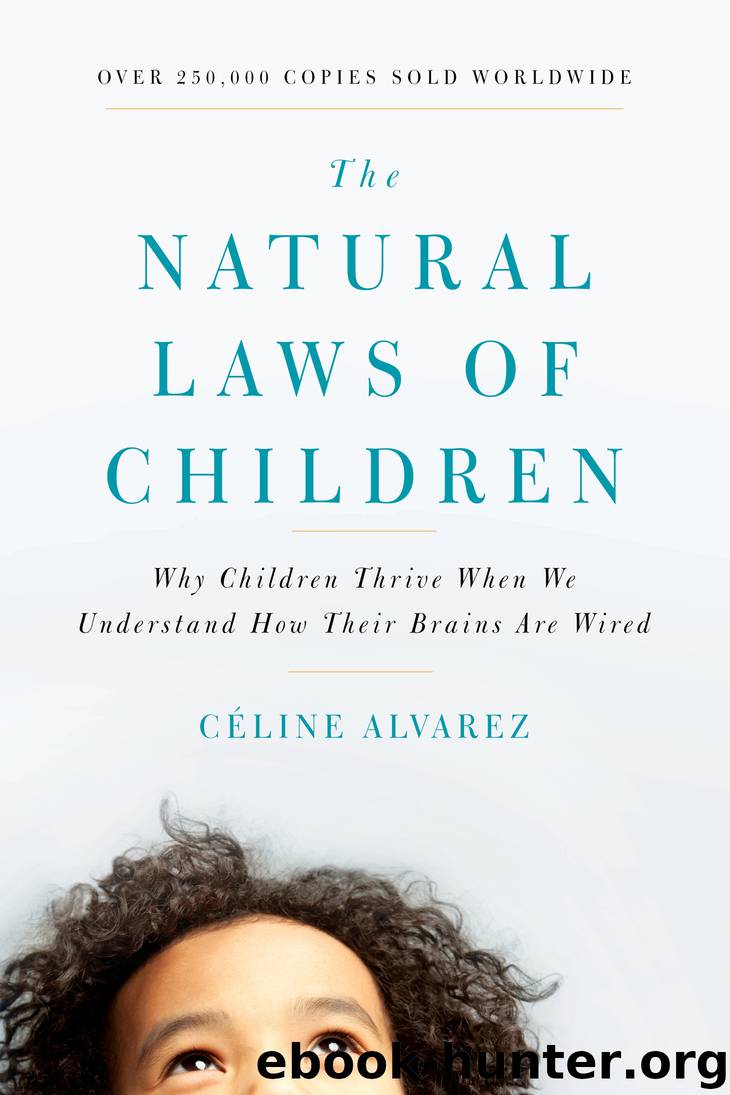The Natural Laws of Children by CELINE ALVAREZ

Author:CELINE ALVAREZ
Language: eng
Format: epub
Publisher: Shambhala
Published: 2019-08-19T16:00:00+00:00
Most of the time, three sounds were presented to the child at a time for a three-period lesson. These might be three letters or two letters and a digraph.
When we presented a letter to a child, we took care to give her the sound most frequently encoded by that letter (in cases where the letter is used to encode more than one sound). For example, for the letter c, we gave the child the sound k as in cat rather than giving her the sound s as in cement, because the letter c encodes the sound k more often that it does the sound s.
You will note that at this stage, the name of the letter is not given to the children. This is because research has strongly recommended separating the name of the letter from the sound it produces, even at the risk of causing children to make reading errors. For example, if a child thinks that the letter p encodes the sound pee and the letter a encodes the sound ay, he will read the word papa as peeay-peeay. To avoid all confusion, we gave the children only the sounds of the letters. We rigorously observed this principle, because we had seen from experience the difficulties that teaching the name of a letter before its sound could cause children to have. The first year at Gennevilliers, we took children into our second-year group who had already done a year of traditional preschool and had therefore learned the name of some letters rather than their sounds. When they tried to read, their progress was impaired by what they had initially learned. For example, they read the word dog as deeojee, and obviously this gave them no chance to understand the meaning of the word, and therefore they had no interest in reading it. It took some time to make them understand that the letter m makes the sound mmmm and not em. For these children, getting started in reading was clearly impaired by the instruction they’d had, which unfortunately in certain cases was already firmly ingrained.
Once they knew how to read, the children learned the names of the letters naturally, particularly thanks to songs like the alphabet song, but only after reading had become automatic and there was no longer any danger of confusion. As long as a child was still not reading smoothly, we never brought up the names of the letters. So we never told a little one, “Here’s the letter ef, which makes a fff sound.” We just said, “Here’s fff.”
We present all the letters of the alphabet this way, as well as the digraphs. For the digraphs we said, “You remember that in the word chhhhip you hear the sound chhhh? Well, look here, you write cccchhhh like this.” A lovely ch pasted on a tablet was then presented to the child. I traced the digraph while pronouncing its sound and invited the child to do the same. The children loved some of these digraphs, like ch or ee, which encoded sounds they heard frequently in words.
Download
This site does not store any files on its server. We only index and link to content provided by other sites. Please contact the content providers to delete copyright contents if any and email us, we'll remove relevant links or contents immediately.
| Administration | Assessment |
| Educational Psychology | Experimental Methods |
| History | Language Experience Approach |
| Philosophy & Social Aspects | Reform & Policy |
| Research |
The Art of Coaching Workbook by Elena Aguilar(50961)
Trainspotting by Irvine Welsh(21515)
Twilight of the Idols With the Antichrist and Ecce Homo by Friedrich Nietzsche(18501)
Fangirl by Rainbow Rowell(9093)
Periodization Training for Sports by Tudor Bompa(8166)
Change Your Questions, Change Your Life by Marilee Adams(7630)
This Is How You Lose Her by Junot Diaz(6777)
Asking the Right Questions: A Guide to Critical Thinking by M. Neil Browne & Stuart M. Keeley(5627)
Grit by Angela Duckworth(5512)
Red Sparrow by Jason Matthews(5389)
Paper Towns by Green John(5086)
Room 212 by Kate Stewart(5034)
Ken Follett - World without end by Ken Follett(4643)
Housekeeping by Marilynne Robinson(4328)
The Sports Rules Book by Human Kinetics(4288)
Double Down (Diary of a Wimpy Kid Book 11) by Jeff Kinney(4204)
Papillon (English) by Henri Charrière(4195)
The Motorcycle Diaries by Ernesto Che Guevara(4008)
Exercise Technique Manual for Resistance Training by National Strength & Conditioning Association(3953)
